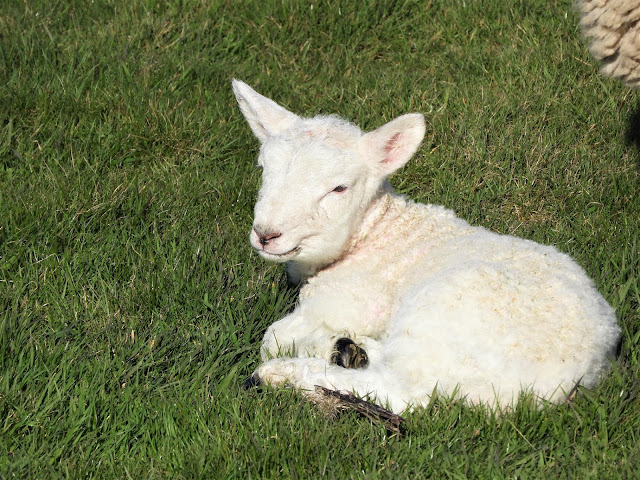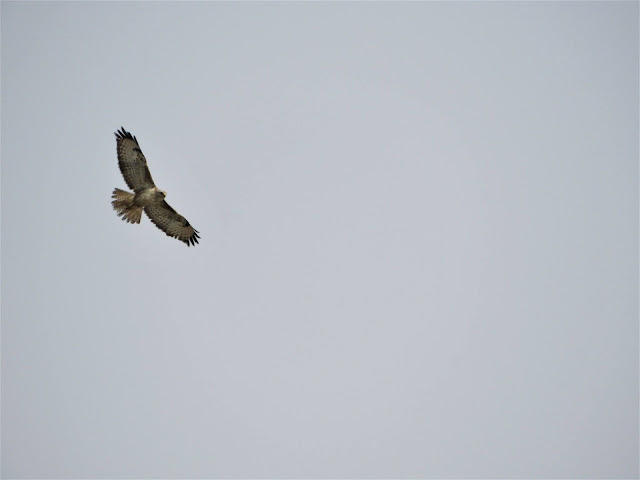A glorious, sun-kissed day with clear skies and a light easterly breeze throughout. Max temperature 10°C.
A very nice variety of migrants on the island, highlights including the first two Whitethroats of the year (both caught and ringed in Millcombe), two Ring Ouzels, both males, one at the Earthquake and the other at Threequarter Wall, a female Common Redstart bobbing around Gannets’ Combe, and a Mistle Thrush (the first of the year) together with a rather late Fieldfare in Barton Field in the late morning.
The star bird however was a ‘control’ Blackcap (i.e. a bird which was already sporting a ring from elsewhere) which had originally been caught as a first-year bird on route to its North African wintering grounds on 29th Sep 2020 at Middle Hill, Gibraltar – a distance of 1,038 miles as the Blackcap flies!
Other sightings of note included six Woodpigeon, a Collared Dove in Millcombe, a lone Whimbrel at Quarter Wall, 85 Puffins in Jenny’s Cove, four fly-by Cormorants, a Herring Gull sitting tight on eggs below the Earthquake, three Sand Martin, 33 Swallow, one House Martin, a reeling Grasshopper Warbler in Millcombe, 18 Blackcap, two Whitethroat, 28 Willow Warbler, seven Chiffchaff, three Goldcrest, three Song Thrush, eight Stonechat, 61 Wheatear (including a number of burly Greenland-type birds), five Pied and one White Wagtail, two Tree Pipits, eight Goldfinch, three Siskin and 52 Linnet.
 |
| There were plenty of Wheatears posing well along High Street on 16 Apr © Dean Jones |
 |
| Not a bird normally seen under the bird feeders: a female Mallard with ducklings, Paradise Row, 16 Apr © Dean Jones |
 |
| Bar-tailed Godwit, Hell's Gates, 15 Apr © Peter Newman |
Finally, the first Emperor Moth of the year was photographed by Ben Arkless near Tibbetts, and the second Holly Blue of the year was on the wing behind Quarter Wall Copse. The moth trap was also deployed overnight, though the number and variety of moths were very low. Inside the Millcombe Heath trap were singles of Dark Sword Grass and Red Chestnut, as well as two each of Early Thorn and Early Grey.
Saturday 17th April
Another beautiful day with more clear skies, sunshine and a very light south-easterly breeze throughout. Max temperature 10°C.
Yet another perfect day for a sailing, MS Oldenburg gliding into the Landing Bay on a glass-like sea via Ilfracombe come the afternoon. Amongst the few on board were Rob Duncan and David Kightley, ready for three full weeks of bird ringing in Millcombe Valley (hopefully the fair weather will continue for them). Keen-eyed birders and friends Andy Jayne and Chris & Mandy Dee also joined the motley crew of bird brains already on the island.
Highlights from another exciting day of Lundy birding included three Common Redstarts (two males and a female) scattered across the island, a stonking male Black Redstart briefly in the Camping Field, the first Kestrel of the year and two Ring Ouzels – one at Benjamin’s Chair and the other at Quarter Wall.
 |
| ...which allowed for some superb prolonged views throughout the day, 17 Apr © Dean Jones |
 |
| I spy something wriggling in the undergrowth – a male Black Redstart foraging in the Camping Field, 17 Apr © Dean Jones |
A total of 110 birds were caught and ringed: one Pied Flycatcher, 46 Blackcap, 47 Willow Warbler, nine Chiffchaff, one Sedge Warbler, one Grasshopper Warbler and three Goldfinch.
We also got some exciting news regarding a colour-ringed Lesser-Black backed Gull (NA5M) which was photographed in High Street Field on 26th Mar 2021. It turns out that this bird was found in very poor condition on Malaga Beach on 28th Nov 2019 and subsequently taken into care. The bird made a rather speedy recovery and was released at Pantano del Limonero, Malaga on 17th Feb 2020 – a distance of 1,002 miles from Lundy! We hope NA5M continues to thrive and perhaps drops into Lundy once again in the near future. Special thanks to José Sánchez Cordero for providing all the information on this bird.
 |
| Lesser Black-backed Gull NA5M, ringed in Malaga, in High Street Field, 26 Apr © Dean Jones |
Weather much the same as the last two days with clear skies and a light easterly wind for the most part. Max temperature 11°C.
Warblers were the theme of the day with a smashing fall of at least 200 Blackcaps and 150 Willow Warblers across the island. Additionally, at least four ‘reeling’ male Grasshopper Warblers were logged, two in Millcombe Valley and singles on the Terrace and at Quarter Wall Pond.
Other highlights included a Dunlin at Rocket Pole Pond – the first of the year – a decent passage of hirundines throughout the afternoon, two Common Redstarts and a handsome male Yellow Wagtail on Quarters Pond.
Also logged were a decent movement of Manx Shearwater past Rat Island first thing (c.30 per minute), two fly-by Cormorant, six Woodpigeon, a lone Golden Plover, two Whimbrel in Barton Field, a Snipe at Rocket Pole Pond, three calling Water Rail, singles of Merlin and Kestrel, 400 Swallow, 100 Sand Martin, 40 House Martin, 10 Chiffchaff, two Sedge Warbler, the Barton Field Fieldfare, a male Blackbird with a beakful of wriggly worms in Millcombe, eight Pied Wagtail, one Grey Wagtail, six Stonechat, 36 Wheatear (with at least four Greenland-type birds), 57 Linnet and 11 Goldfinch.
 |
| Chiffchaff, High Street, 18 Apr © Dean Jones |
Non-avian sightings included the first Large and Green-veined White butterflies of the year – both singles in Millcombe.
Monday 19th April
The wonderful and calm weather continued for another day. Max temperature 11°C.
Highlights included a lone Sanderling on the Main Track (the 16th spring record for Lundy) and the first Reed Warbler of the year in the bottom shelf of a mist-net in the Secret Garden. Incredibly the Reed Warbler, like the Gibraltar Blackcap mentioned above, was already wearing a ring when discovered. Results now show that this bird was caught as a young, recently fledged bird (age code 3J) on St Mary’s, Isle of Scilly on 6th Jul 2019 – meaning that this stunning little bird has crossed the Sahara Desert at least four times in its life so far!
 |
| The Sanderling lingered on the Main Track for most of 19th Apr, providing superb views for passers-by © Dean Jones |
Other birds logged were two Cormorant, a fly-over Golden Plover, two Whimbrel in Barton Field, a single Merlin, 80 Swallow, 90 Sand Martin, two House Martin, 75 Blackcap, 45 Willow Warbler, nine Chiffchaff, a single Sedge Warbler, three Grasshopper Warblers, singles of Whitethroat and Ring Ouzel, three Tree Pipit, a single Yellow Wagtail, 10 Pied Wagtails, two White Wagtails in Tillage Field, two Song Thrush, two Stonechat, 30 Wheatear along the south up to the Battery, a male Common Redstart (caught and ringed), 18 Linnet, nine Goldfinch, a Lesser Redpoll and three Siskin.
 |
| The year's Puffin productivity studies are now well underway, – here Volunteer Wardens Ben and Eleanor mapping burrows in Jenny's Cove, 19 Apr © Dean Jones |
Tuesday 20th April
Overcast in the morning, next to no wind and temperatures of up to 12°C.
These conditions brought with them yet another spectacular arrival of migrants to the island, the bulk involving Blackcap (230) and Willow Warbler (150) once again. The settled conditions also brought the first Cuckoo of the year – a cracking male – which had been seen and heard singing in various parts of the island from St John’s Valley to Quarter Wall Copse throughout most of the day.
A spectacular total of 307 birds were caught and ringed throughout the day: 163 Blackcap, 104 Willow Warblers, 15 Chiffchaff, three Whitethroat, two Grasshopper Warbler, two Sedge Warbler, one each of Goldcrest, Stonechat and Tree Pipit, three Meadow Pipit, one Pied Flycatcher, two Wren, 5 Linnet and a Goldfinch. Excellent work, team!
Clear skies and a light easterly breeze first thing which picked up quite significantly from mid-morning onwards. Max temperature 12°C.
Highlights from a busy day of Fire and Rescue training included a possible Siberian Chiffchaff, caught and ringed in Millcombe first thing, and yet another day of decent Blackcap passage with a least 165 birds logged through the day.
 |
| Lundy's Fire and Rescue Team posing in front of Old Light after a busy day of training and equipment checks, 21 Apr © Kobe Garfoot |
 |
| Possible tristis Chiffchaff (left) with nominate collybita Chiffchaff, 21 Apr Dean Jones |
Other sightings of note were three Mallard with 12 small ducklings at Pondsbury, six Teal, two Whimbrel, a single Snipe, the male Kestrel, 30 Swallow, 17 Sand Martin, 12 House Martin, 45 Willow Warbler, eight Chiffchaff, a single Sedge Warbler on the Terrace, four Whitethroat, three Grasshopper Warbler, two Song Thrush, a male Ring Ouzel at Quarter Wall, a Mistle Thrush in St Helen's Field, two Stonechat, a fly-over Grey Wagtail, three White Wagtail, five Pied Wagtail, 32 Linnet and a single Siskin.
Thursday 22nd April
Blue skies and a stiff easterly wind for most of the day up until the early evening when it dropped to a gentle breeze. Max temperature 12°C.
The strong winds made for tricky birding, most birds hunkering down for the majority of the day and out of sight. However, despite the difficult conditions, the team did manage to find the first Garden Warbler of the year in the reasonably sheltered Secret Garden come the afternoon.
Other birds logged included three Whimbrel in Helicopter Field, a Sparrowhawk over the Laundry Garden, 50 Swallow, nine Sand Martin, six House Martin, 50 Blackcap, 16 Willow Warbler, two Chiffchaff, the lingering Mistle Thrush, the male Ring Ouzel at Quarter Wall for another day, two Song Thrush in Millcombe, a Tree Pipit, 32 Wheatear (including at least five Greenland birds at Quarter Wall), 23 Linnet, 15 Goldfinch and four Siskin.
The first of the island’s Starling chicks are not far off fledging now, with at least 51 nests in the Village and Old Lighthouse now containing noisy young birds!
Friday 23rd April
A day of clear skies and a strong east/south-easterly wind throughout. Max temperature 11°C.
Highlights included the first Whinchat of the year at Quarter Wall and the first three Ringed Plovers – two of which were foraging within a small flock of five Dunlin in South West Field in the afternoon.
 |
| Whimbrel enjoying the morning sunshine in Barton Field, 22 Apr © Dean Jones |
Report composed of sightings by Ben Arkless, Chris & Mandy Dee, Rob Duncan, Jamie Dunning, Rosie Ellis, Eleanor Grover, Andy Jayne, Dean Jones, David Kightley, Peter Newman, Tony & Ann Taylor and Mark & Julia Webber.













































